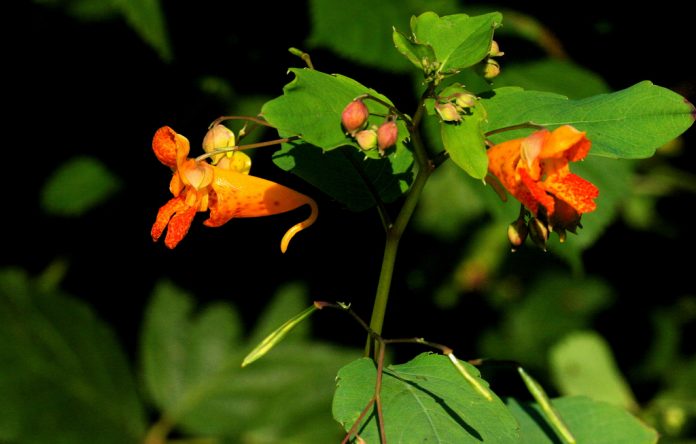
It seems like every time we see articles about wildflowers and weeds, they are talking about invasives and how to eradicate them. They are always in our livestock’s pastures and hayfields causing problems for producers.
Every morning, while walking my dogs down my quiet county road, I am always looking for something good to start my day. I have noticed there is one weed that not only keeps to the wet shady areas but also tends to help more than it harms.
Jewelweed, also commonly called touch-me-not, is an annual plant in the balsam family native to North America. It is commonly found in moist, shady areas such as low woodland areas, and along lakes and streams. They begin blooming in mid-summer and continue until killed by frost. The flowers are unscented, orange with reddish spots.
There is another type of jewelweed that has yellow flowers with no spots. The leaves of both types have scalloped edges and microscopic hairs that trap a thin layer of air on the surface. This layer of air helps the leaves to appear waterproof. The morning dew will bead up on the leaves and glisten like “jewels,” which is where the plant gets its name.
The stems are smooth and almost translucent, ranging in various shades of green. They produce elongated fruits that, when ripe, burst explosively when touched. The sections of the pod roll back into tightly curled strips to eject four to five seeds. This explosion of the seed pods is where the name “touch-me-not” comes from.
Helpful in nature
These plants are very attractive to pollinators. The yellow flower attracts bumble bees while the orange flower attracts hummingbirds. It serves as a critical food source after other nectar plants have gone to seed. This nectar and the insects it attracts are critical to the hummingbirds as they incorporate the plant’s locations into their migration routes.
The orange flowered jewelweed is also helpful in the eradication of unwanted invasive weeds by forming large, dense stands that out-compete them. Jewelweed has few pest problems, although deer will browse on their leaves and mice and many birds will eat the seeds.
Health benefits
Jewelweed has many health benefits as well. It is probably no coincidence jewelweed is often found growing close by poison ivy. It has long been used to help relieve the itch and sting of poison ivy and insect bites. I have crushed the leaves and added them to goat milk to make poison ivy soap. The crushed leaves can also be used as a poultice put directly on the rash.
I have also heard of people boiling the leaves to make a tea or using the liquid to make ice cubes to apply to the skin as well.
So, the next time you are out for a walk and see jewelweed growing, remember the fun you had as a child popping the seed pods, while enjoying the cool shade where they grew, and say goodbye to the hummingbirds as they start their migration as fall draws near. It is always nice to find a weed that has more benefits than it has issues.












